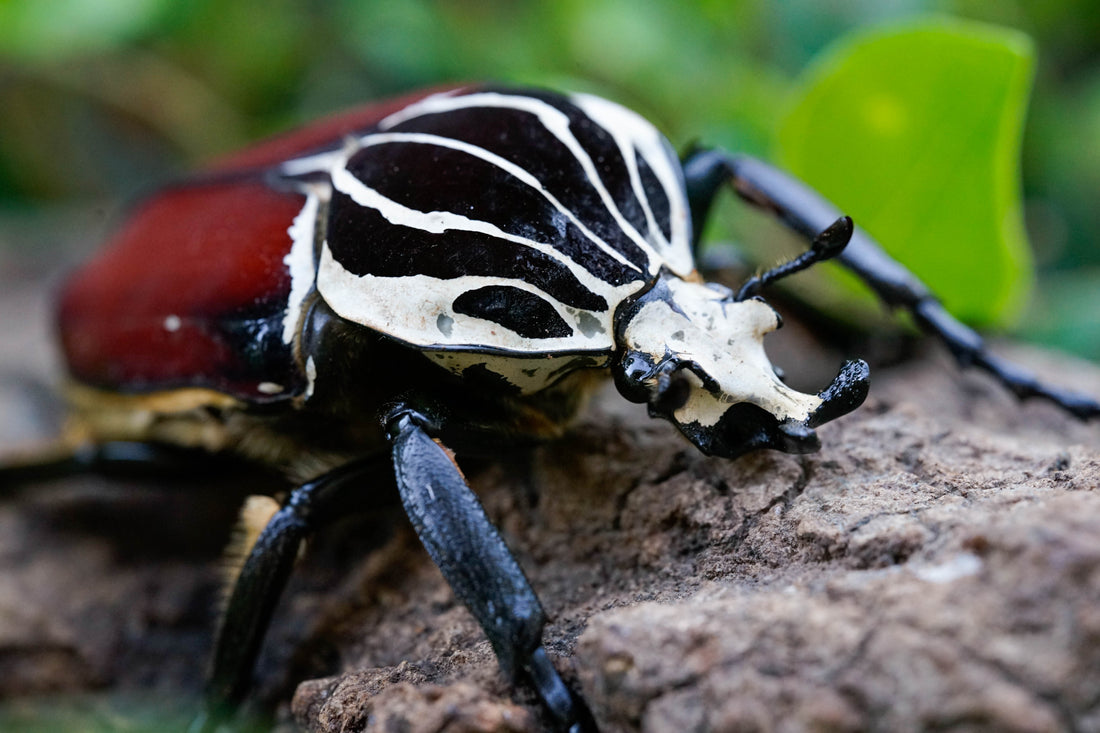
Goliath beetle caresheet
Share
Adults:
- Size: 48-110mm
- Adult life span once active: 5-12 months
- Temperature: 68-77°F
- Humidity: 60-70%
- Food: Beetle jelly or fruits(no citrus)
Breeding:
- Required temperature for breeding: 72-80°F
- Minimum container size for egg laying: 8 in x 4 in x 8 in. Bigger containers are always the better option for breeding!
- # of eggs laid on average: 30-60 eggs.
- Flake soil humidity adjustment: The amount of water is appropriate when you can form a ball by squeezing the flake soil with your hand. Water seeping out of your hands during the process indicates that there is too much water.
- Set-up: Pack the bottom 5cm of the container tightly and fill up the remaining space loosely with flake soil. Place objects such as sticks or barks at the top so that the beetle can flip itself over if needed. Lastly, don't forget to regularly change fruits or beetle jelly for the beetle to feed!
Set-up example:

Larvae:
- Food: Flake soil for L1. Koi pellets from L2 onwards.
- Provide the larva with a few pellets every day or two. You may have to give more or less pellets depending on the size of the pellets. Having a consistent feeding schedule is key for their growth.
- Temperature: 72-77°F.
- Humidity: 50-60%
- Larval duration: 5-10 months
- Pre-pupa/pupa duration: 4-6 months
- Container size recommendations:
- L1: 2oz deli cup
- Early L2: 4oz deli cup
- Late L2 - Early L3: 16oz deli cup
- L3: 16-32oz container(Big male larvae may require more space)

L2 larva in 2oz container

Multiple L3 larvae in a tackle box. These will be moved to bigger containers since they are obviously too big now to be in this box. I'm just sharing this to show that they do not require much space!
- Pupation: This species requires inorganic substrate for pupation. When larvae are ready to build their pupal cells, they will wander around the container in search of inorganic substrate. Hobbyists call this the "wandering stage." During this stage, they are known to easily escape their containers so it's important that the lids of the containers are properly secured. For the inorganic substrate, I personally use a blend of clay and sand but some people use 100% clay. According to a famous European breeder, Benjamin Harink, a mix of 70% sand and 30% peat works too.
Once the larva digs into the inorganic substrate, fight the temptation to dig them up. Leave them alone for at least 5 months. This is because if you disturb them during their pre-pupal stage, they can easily die.
Here is a video by a Taiwanese breeder on setting up for pupation:
Important notes:
- Do NOT put larvae together in the same container. They can cannibalize each other!
- Flake soil is not needed after the L2 stage. Feel free to keep them in any moist substrate that does not contain any harmful chemicals. I personally keep them in a mixture of 70% peat and 30% sand.
- The size of the koi pellets does not seem to matter for growth. The protein content of the pellets is the most important.
- I've seen hobbyists wet the koi pellets before giving it to their larvae; however, I find this step unnecessary if the substrate is kept moist.
- Frequent cleaning of their enclosure is highly recommended to lower the chance of mite outbreaks (i.e remove uneaten pellets every few days, replace the substrate every 2-3 weeks, etc..)
- Weigh the larvae every week to ensure that they are growing properly.
- Some larvae tend to not wander around so if they are suddenly not eating or losing weight, it could be a sign that they are looking to pupate.